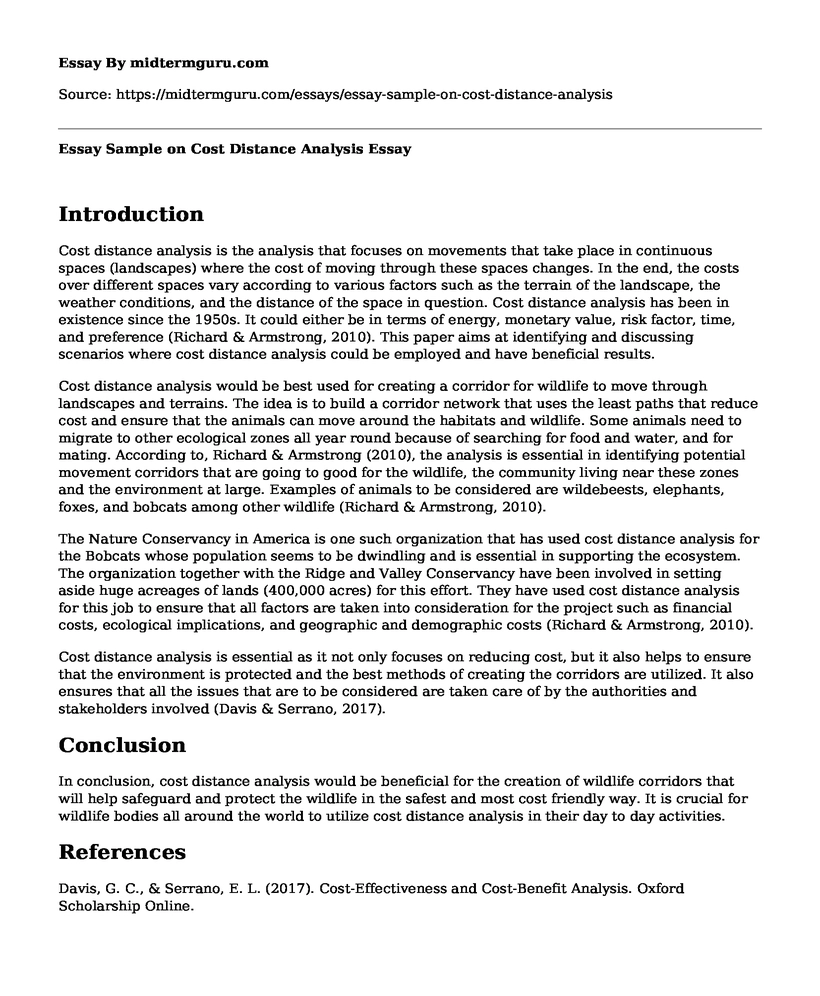Introduction
Cost distance analysis is the analysis that focuses on movements that take place in continuous spaces (landscapes) where the cost of moving through these spaces changes. In the end, the costs over different spaces vary according to various factors such as the terrain of the landscape, the weather conditions, and the distance of the space in question. Cost distance analysis has been in existence since the 1950s. It could either be in terms of energy, monetary value, risk factor, time, and preference (Richard & Armstrong, 2010). This paper aims at identifying and discussing scenarios where cost distance analysis could be employed and have beneficial results.
Cost distance analysis would be best used for creating a corridor for wildlife to move through landscapes and terrains. The idea is to build a corridor network that uses the least paths that reduce cost and ensure that the animals can move around the habitats and wildlife. Some animals need to migrate to other ecological zones all year round because of searching for food and water, and for mating. According to, Richard & Armstrong (2010), the analysis is essential in identifying potential movement corridors that are going to good for the wildlife, the community living near these zones and the environment at large. Examples of animals to be considered are wildebeests, elephants, foxes, and bobcats among other wildlife (Richard & Armstrong, 2010).
The Nature Conservancy in America is one such organization that has used cost distance analysis for the Bobcats whose population seems to be dwindling and is essential in supporting the ecosystem. The organization together with the Ridge and Valley Conservancy have been involved in setting aside huge acreages of lands (400,000 acres) for this effort. They have used cost distance analysis for this job to ensure that all factors are taken into consideration for the project such as financial costs, ecological implications, and geographic and demographic costs (Richard & Armstrong, 2010).
Cost distance analysis is essential as it not only focuses on reducing cost, but it also helps to ensure that the environment is protected and the best methods of creating the corridors are utilized. It also ensures that all the issues that are to be considered are taken care of by the authorities and stakeholders involved (Davis & Serrano, 2017).
Conclusion
In conclusion, cost distance analysis would be beneficial for the creation of wildlife corridors that will help safeguard and protect the wildlife in the safest and most cost friendly way. It is crucial for wildlife bodies all around the world to utilize cost distance analysis in their day to day activities.
References
Davis, G. C., & Serrano, E. L. (2017). Cost-Effectiveness and Cost-Benefit Analysis. Oxford Scholarship Online.
Richard, Y., & Armstrong, D. P. (2010). Cost distance modelling of landscape connectivity and gap-crossing ability using radio-tracking data. Journal of Applied Ecology, 47(3), 603-610.
Cite this page
Essay Sample on Cost Distance Analysis. (2022, Sep 07). Retrieved from https://midtermguru.com/essays/essay-sample-on-cost-distance-analysis
If you are the original author of this essay and no longer wish to have it published on the midtermguru.com website, please click below to request its removal:
- Paper Example on Farm Management and Finance
- Starbucks: Recommendations Essay
- History of the Negotiations That Led to Border Security - Research Paper
- Security Technology: Border Security - Essay Sample
- 1973: US DoD Develops G.P.S. and Geospatial Tech - Essay Sample
- Clinician's Unique Skill: Understanding Patient Goals & Prognosis - Essay Sample
- Westward Expansion: 19th Century Migration & Manifest Destiny - Essay Sample







